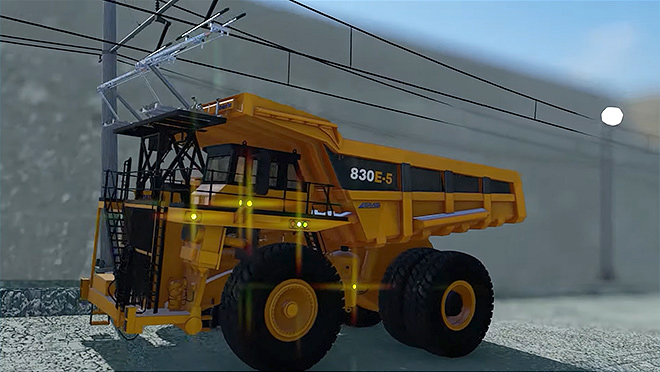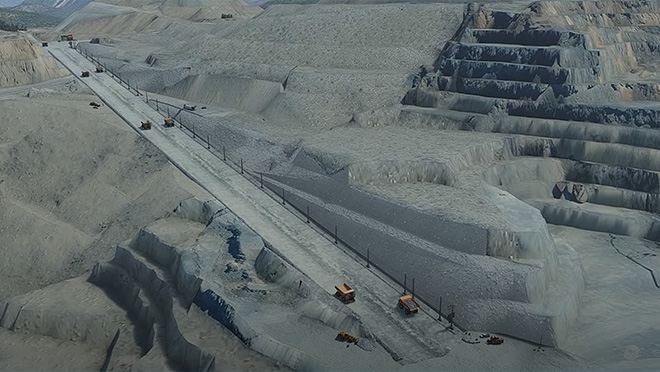A net-zero mine? Copper Mountain takes electrifying first step

Huge trucks get electric trolley assistance at operation near Princeton, B.C.
When you examine a mine's carbon footprint, diesel's the devil. For decades, it has been the go-to fuel for mining operations, from haul trucks, to other equipment including drills.
So how does a mining operation such as Copper Mountain mine near Princeton, B.C. take steps toward chasing a net-zero emissions objective by 2035? By installing a one-kilometre section of electric trolleys designed to help 11 full-size hybrid Komatsu trucks haul ore uphill from the main mining pit to the operation's primary crusher.
Think of it as the mining equivalent of the overhead trolleys that have powered public buses in Metro Vancouver since 1948.
The trolley-assist operation is the first of its kind in North America, and it's another example of how B.C. is increasingly powered by water. Using clean and renewable hydroelectric power to shift B.C. homes, businesses and industry away from fossil fuels is a major plank in the Province of B.C.'s ambitious climate action plan. BC Hydro's Electrification Plan is expected to result in greenhouse gas emission reductions of 930,000 tonnes per year by 2026, the equivalent of taking about 200,000 cars off the road.
How electricity is helping a copper mine meet its sustainability goals
The Copper Mountain mine, located 20 km south of Princeton in B.C.'s southern interior, produces around 100 million pounds of copper equivalent per year. Managing environmental responsibilities is integral to the mine's operations. Copper Mountain is aligned with the Paris Agreement and aims to reduce carbon intensity by up to 50% in five to seven years, en route to an aggressive goal of net-zero GHG emissions by 2035.
And key to that is the installation of the one-km electric trolley assist in the spring of 2022. Each truck is expected to displace the use of 400 litres of diesel per hour, or about a tonne of CO2 emissions.
"We first started exploring trolley assist back in December 2016," says Walt Halipchuk, Copper Mountain's director of sustainable business development and the person who has overseen the project from its inception. "Then in 2019, BC Hydro funded a feasibility study, and that's when it really shifted gears."
BC Hydro's key accounts and industrial marketing teams collaborated with Copper Mountain to secure funding.
"We also won funding for GHG projects from CleanBC the same year, along with a second grant in 2020," explains Halipchuk. "We began by developing the ramp, moving eight million tons of material to build it. Obviously, we have the equipment right here at the mine to do that, and it moved along at a good pace, but with so many switchbacks along the roads in the mine, it was quite an undertaking."

Big math: house-sized trucks can move twice as fast on electric drive
At almost 15 metres long by seven metres high and eight metres wide, the Komatsu 830E-5 hybrid trucks are bigger than the average two-storey house. And, when loaded, they can weigh in at over 900,000 pounds, or 409 metric tonnes.
Yeah, you read that right. That's the equivalent of 30 loaded transit buses, or nearly 300 cars.
Equipped with a 2,600-horsepower diesel motor, the hybrid trucks are also equipped with an electric drive system that requires three megawatts of peak power to make it move. The trucks can only run on their electric drive motors when they're connected to the trolley assist. But move they do, at a speed of up to 35 km/h, more than double the top speed of what the diesel motor can manage.
The BC Hydro Interconnections team worked throughout 2021 to ensure that Copper Mountain can access the additional load needed to power the project. The finished trolley system can consume 12 megawatts at any one time – enough for four trucks to be on the ramp hauling while the other seven are loading or unloading elsewhere in the pit.
"I've got over 30 years' experience building mines in Peru, the Dominican Republic and northern B.C., but this is the most challenging project I've ever done in my career," says Halipchuk. "We needed to integrate the needs of the mine, the brand new hybrid haul trucks and the critical electrical infrastructure – they all have to work together perfectly."
Why Copper Mountain has invested $40 million in trolley assist
The Copper Mountain trolley assist project has cost around $40 million, and two more phases of trolley assist are planned. The mining company is counting on that investment paying off for a number of reasons:
- Rising carbon taxes. As carbon taxes rise, the trolley assist will help to dramatically reduce Copper Mountain's liability.
- Rising diesel prices. Each hybrid Komatsu haul truck will displace 400 litres of diesel (or 1 tonne of C02) per hour while working via trolley assist. Plus, moving to BC Hydro's clean electricity creates a more stable costing model compared to relying on volatile diesel prices and supply.
- Faster trucks. While using trolley assist, the hybrid trucks enable Copper Mountain to haul more ore in less time.
- More responsible metals. The BC Government is helping B.C.'s mining industry establish "responsible metals" credentials to products as they transfer along the supply chain, so that these products can then be traded at a premium. The "responsible metals" label will make Copper Mountain's product more valuable.
Mine wants to spread the word about trolley assist benefits
As one of the few mines in the world with working electric trolley assist – the first was Boliden's Kevitsa mine in Finland – Copper Mountain is keen to spread the word.
"This has gathered a lot of interest from other mining companies, especially in Canada," says Halipchuk. "So we're having a symposium to meet with other mining companies, and sharing our learnings."
Copper Mountain also plans to host a public demonstration of the trolley assist project on May 25, 2022, during BC Mining Week.
"People can come and see the trolley assist up close and join us for a big community day in Princeton town square," says Halipchuk.
For now, you can see how the trolley assist will work in this Copper Mountain video.
Related: